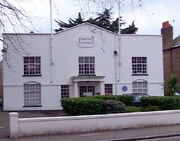
Ealing Studios' main entrance in 2008.
- You may be looking for its in-universe counterpart.
Ealing Studios (sometimes called Ealing Film Studios) is a famed British film company and facilities provider located in the London borough of the same name. Studios have existed on the site since 1896, making it officially the oldest studio lot in the world. However, the Ealing legacy on the site dates back only to 1929, and it has only been called "Ealing" since 1931.
As a recording studio[]
During the run of the original series, video cameras were banned at Ealing.[1] This in general limited its use on the mostly videotaped Doctor Who. It was principally used for filming special inserts that were included in scenes that were otherwise videotaped.
However, there were occasions in which the main cast would film the bulk of episodes at Ealing.
Use in special effects and insert shots[]
While far more important to the British film industry in general than to Doctor Who, it nevertheless played a significant role in recording filmed inserts that were mixed live and/or edited into the principally videotaped Doctor Who episodes. In the very early days of the programme, editing as we understand it today wasn't practicable. Ealing was thus used to find ways to get around the need to edit. For instance, if a scene required one character to talk to another over a video monitor, the part on the monitor would be filmed at Ealing, then played into a monitor that was on set during the video recording. This allowed for a "special effect" to be achieved without editing the videotape.
Moreover, most model work and special effects were filmed at Ealing. Almost every William Hartnell and Patrick Troughton story availed themselves of Ealing's facilities for second unit or special photography. Indeed, it was still quite heavily used in this way up until The Five Doctors.[2] Its usage for special effects in Doctor Who may have diminished in an effort to record more special effects on video so that they matched visually with the videotaped scenes into which they were spliced.[1] Moreover, after the Davison era, model shots were comparatively scarcer than they had been in the past, while at the same time the BBC's ability to achieve effects in-house increased. Ealing wasn't used again by Doctor Who until the filming of the Tenth Doctor two-part adventure The Impossible Planet/The Satan Pit. As in the past, Ealing was used for special effects recording only, being a suitable location for the filming of the practical effect of fire.[3]
Use in principal photography[]
On occasion, principal photography at the usual studios wasn't possible. In such cases, some portions of Doctor Who first unit photography occurred on film at Ealing and some happened at BBC Television Centre, Riverside or Lime Grove. A good example of a serial filmed at multiple studios is The Space Pirates, in which the main cast filmed at least one whole episode at Ealing, Lime Grove and Television Centre. [4] Ealing was less used for principal photography in the colour era — perhaps because of the more prohibitive costs of colour film stock — but it was nevertheless where the Third Doctor's climactic battle with the Nestene Consciousness was filmed in Spearhead from Space,[5] and where Leela's eyes turned from blue to brown in Horror of Fang Rock.
Use by single members of the main cast for principal photography[]
Because of the gruelling, almost year-round production schedule of monochromatic Doctor Who, breaks had to be occasionally given to cast members in the middle of recording stories. This was usually accomplished by a trip to Ealing. A cast member would go to Ealing, record a few lines of dialogue and then this scene would be dropped into the episode that they had actually not been present to record. For example, Ealing was used to pre-film sequences involving Carole Ann Ford in The Aztecs, William Russell in The Reign of Terror[6] and Patrick Troughton in The Web of Fear.[7] Thus, Ealing didn't just allow the production staff to find a way around logistical problems, it also enabled the cast to go on holiday.
As an exterior location[]
The studio's exteriors have been seen in the program as well, notably as the backdrop to Ian and Barbara's return to London in The Chase and as the backdrop to a WOTAN battle in The War Machines.[2]
As documentary subject[]
For the documentary, "A Darker Side", producer Philip Hinchcliffe and designer Roger Murray-Leach returned to Ealing for a discussion of difficulties of integrating film and videotape into the production of a Doctor Who story. (BBC DVD: Planet of Evil)
External links[]
Footnotes[]
- ↑ 1.0 1.1 Shannon Sullivan's exploration of Warriors of the Deep.
- ↑ 2.0 2.1 Doctor Who locations guide
- ↑ Shannon Sullivan's exploration of "The Satan Pit/The Impossible Planet"
- ↑ Shannon Sullivan's exploration of The Space Pirates
- ↑ Shannon Sullivan's exploration of Spearhead from Space
- ↑ Shannon Sullivan's exploration of The Reign of Terror
- ↑ Shannon Sullivan's exploration of The Web of Fear
